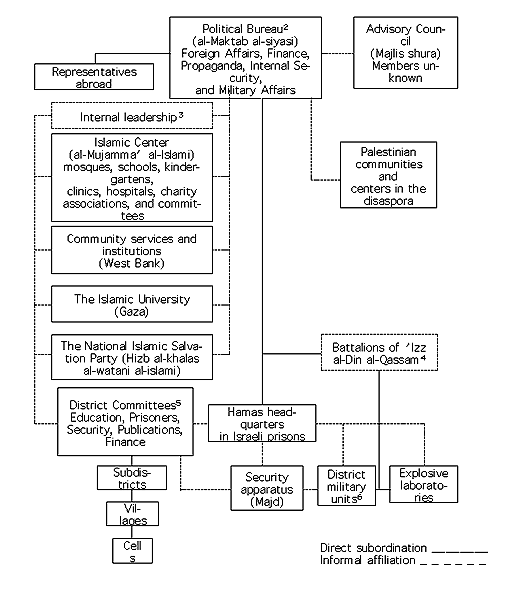|
|
|
|
The Palestinian Hamas: Vision, Violence, and Coexistence
Shaul Mishal and Avraham Sela
2000
Appendix 1: Hamas’s Internal Structure 1

Endnotes
Note 1: For a comparison with another Islamic movement with a similar structure, such as the Islamic Tendency Movement of Tunisia, see François Burgat and William Dowell, The Islamic Movement in North Africa (Austin: University of Texas Press, 1993), p. 189.Back.
Note 2: The Hamas leadership outside the West Bank and the Gaza Strip—the full list of members and functions is officially unknown. Its prominent members include Khalid Mash`al (chairman since 1995), Musa Abu Marzuq (chairman, 1989–1995), `Imad al-`Alami (representative in Syria since 1998), Muhammad Nazzal (representative in Jordan), Ibrahim Ghawsha (spokesman), Mustafa Liddawi (representative in Lebanon), Mustafa Qanu` (representative in Iran since 1998), and 'Usama Hamdan (representative in Sudan).
Note 3: A group of influential figures in the West Bank and Gaza operating informally and in a decentralized manner.
Note 4: A title for all operational military units, informally based on geographic district.
Note 5: Five are in the West Bank (Jenin, Tulkarm, Nablus, Ramallah, and Hebron), and seven are in the Gaza Strip (Gaza, Rafah, Dair al-Balah, Jabaliyya, Khan Yunis, Shati', and Nusairat), with functions similar to those of the Political Bureau.
Note 6: Between 1996 and 1998, military activities in the West Bank were carried out by units from Hebron, Jerusalem, and the northern region of the West Bank. They were nominally controlled by Hamas’s Political Bureau in Amman. Since the establishment of the Palestinian Authority in the Gaza Strip, the military units of `Izz al-Din al-Qassam have had difficulty operating in the Gaza Strip, raising doubts about their ability to operate as district apparatuses.